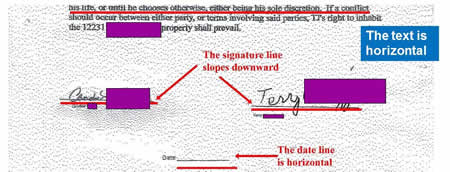Generally, a document examiner cannot determine that a signature on a photocopy is cut-and-paste unless the source signature is available. There are exceptions to this rule. When a person is careless creating a document that will be passed as authentic, the document examiner can determine the photocopy is not made from an authentic document. Signs of the cut-and-paste will be left by the perpetrator.

In a case I demonstrated that a photocopy was created using cut-and-paste signatures. Attributes of the typed text on the document were compared with the signature lines on the document. Also, the font used for the name under the signature line was compared with the font in the remainder of the document.
A person created a contract, then placed two signatures onto the document. I could not determine whether they were placed onto the page using computer software such as Photoshop, or they were placed onto the page from a manual cutout. These are signs of the cut-and-paste.
The left-side signature line is indented further right than the bullets in the primary text. This alone does not mean the signature line was cut-and-paste onto the contract. It is possible that a person typed leading spaces before starting the signature line.
A telltale sign of cut-and-paste in the example is the signature lines are sloped down to the right for each signature. All the computer printed text on the page was horizontal. If the signature lines were printed on the page with the rest of the printed text, they would have been printed horizontally. The cut-and-paste was done carelessly.

The signature lines for each person do not align vertically. The signature line on the left side of the page is higher than the signature line on the right side of the page. Had they been printed onto the document, they would align vertically. The vertical distance between the two lines is different from the vertical distance between two of the printed lines of text. This is additional that the signature is a result of cut-and-paste.

There were many other anomalies on the page, including differences in the font in the names printed below the signature lines and the font in the text of the contract. A result of a microscopic examination, shown in Figure 3, is the dot patterns are different in different parts of the document. The image on the left side of Figure 3 shows a forty times enlargement of the signature on the left side of the page. The image on the right side of Figure 3 shows a forty times magnification of the signature on the right side of the page. The remainder of the document shows a dot pattern similar to the right-side signature.
These other anomalies are further evidence of cut-and-paste.
The result of the examination is signatures on the contract were not part of the original contract. Therefore, the contract document is not authentic. In this case the source documents for the signatures on the contract were not available. The plaintiff alleged the original contract had been lost. The discrepancies resulted in an opinion the document was created by a cut-and-paste of the signatures onto the typed document. The mechanism used to place the signatures onto the typed document is unknown.
Mike Wakshull, MS, CQE, PMP, CISA, is a forensic document examiner based in Temecula, CA. He holds a graduate school certificate in forensic document examination from East Tennessee State University and a master's degree in Technology Management from the University of Denver. Mike is Chair of the 2012 National Association of Document Examiners Conference in San Diego.
©Copyright - All Rights Reserved
DO NOT REPRODUCE WITHOUT WRITTEN PERMISSION BY AUTHOR.













